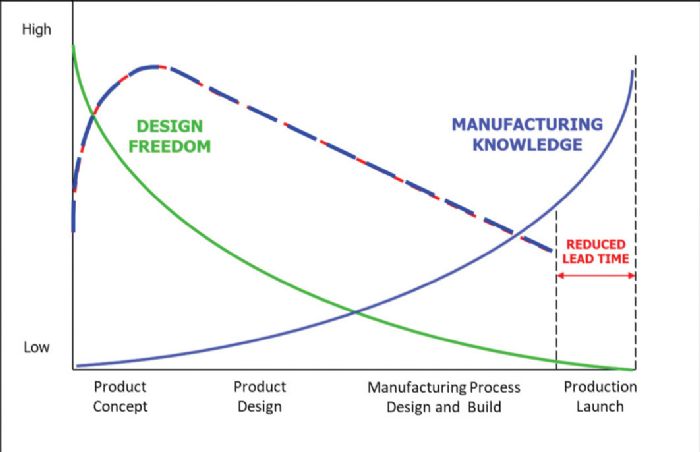Explain key material properties such as yield strength, tensile strength, elongation and work-hardening rates, and their relevance to metal forming processes. Address the concepts of material flow and strain distributions, and how they relate to part design, manufacturability and dimensional stability. And, don’t forget the importance of surface finish and coatings, especially in cases where parts require post-forming treatments.
For products produced from coated steels, explain the differences between hot-dipped galvanized, hot-dipped galvannealed, electrogalvanized and aluminized steel, and how these products affect die life and downstream tooling performance—spot welding, for example.
For products made from stainless steel or aluminum, explain how different grades and tempers can affect tool life, lubrication selection and process capability. Stamping a part from Type 6061-T6 aluminum may require purchasing material in the T4 condition, forming in the die, and then artificially aging to the T6 condition due to complex product geometry and limited ductility of this alloy in the T6 condition.
Product Design and Quality
Explain how to estimate the manufacturing cost of metal parts based on design choices, material selection and other factors. Explain the role of tooling and dies, addressing topics such as clearances, tooling materials and maintenance costs.
Provide detailed explanations for sheet metal features such as shearing, punching, cutting clearance, burr height, shaving, lancing, bending, flanging, embossing, stretching, deep drawing, redrawing, thickening and thinning patterns, and ironing. Don’t forget to address nonfunctional product features such as match cuts, mismatch cuts and bypass notches.
Introduce participants to software tools, including metal forming simulations, which can aid in design analysis and optimization, especially when addressing complex part geometries and how to simplify designs when necessary. Emphasize how design choices can impact sustainability and waste reduction. Explain the role of prototyping and testing in verifying design changes and ensuring manufacturability.
Encourage participants to apply DFM principles iteratively, revising designs based on insights gained during the workshop. Emphasize the importance of a continuous-improvement mindset in design and manufacturing.
Cover quality-control measures and inspection techniques, including the use of datum targets, holding fixtures and attribute gauging to ensure that parts meet design specifications without the added expense of digital scanning or measuring parts on a coordinate measuring machine.
Surface Treatments
 Surface treatments extend the versatility of stampings and sheet metal fabrications by adding a decorative and/or protective layer of another metal alloy to the base material or substrate.
Surface treatments extend the versatility of stampings and sheet metal fabrications by adding a decorative and/or protective layer of another metal alloy to the base material or substrate.
On steel, coaters commonly use electroplating to deposit another metal grade. On aluminum, anodizing sees routine use to create a stable, insulating oxide layer. To enhance the electrical conductivity of aluminum, a chromate conversion coating may be applied that also prevents surface corrosion.
Illustrate how outside sharp corners may receive twice as much plating as flat surfaces. Also, make allowance for pitch diameters for screw threads, which can accumulate as much as four times the plating thickness as flat surfaces. Tapped holes may require retapping after plating to ensure accuracy, or can be plugged to avoid retapping. Projections accumulate more plating than other areas and recessed areas may be difficult to plate, resulting in little or no coverage.
Lap-welded joints can trap plating chemicals. One solution: Weld in areas embossed approximately 0.015 in. high or higher to allow for flushing between the surfaces. Consider adding drain or vent holes to the design for plating solutions and rinsing. Design features such as dimples can prevent part sticking during barrel plating, and tabs/holes may be needed for attachment to part racks.
By covering these key topics, your customer will gain a solid foundation in DFM for metal formed products and be better equipped to design manufacturable, cost-effective and high-quality products. MF
Industry-Related Terms: Anodizing,
Bending,
Burr Height,
Burr,
Case,
Chromate Conversion,
Chromate,
Conductivity,
Conversion Coating,
Datum,
Die,
Drawing,
Ductility,
Electroplating,
Forming,
Layer,
Manufacturability,
Plate,
Roll Forming,
Shearing,
Slide Forming,
Stainless Steel,
Substrate,
Surface,
Tensile Strength,
Thickness,
TransferView Glossary of Metalforming Terms Technologies: Management







 Surface treatments extend the versatility of stampings and sheet metal fabrications by adding a decorative and/or protective layer of another metal alloy to the base material or substrate.
Surface treatments extend the versatility of stampings and sheet metal fabrications by adding a decorative and/or protective layer of another metal alloy to the base material or substrate. 